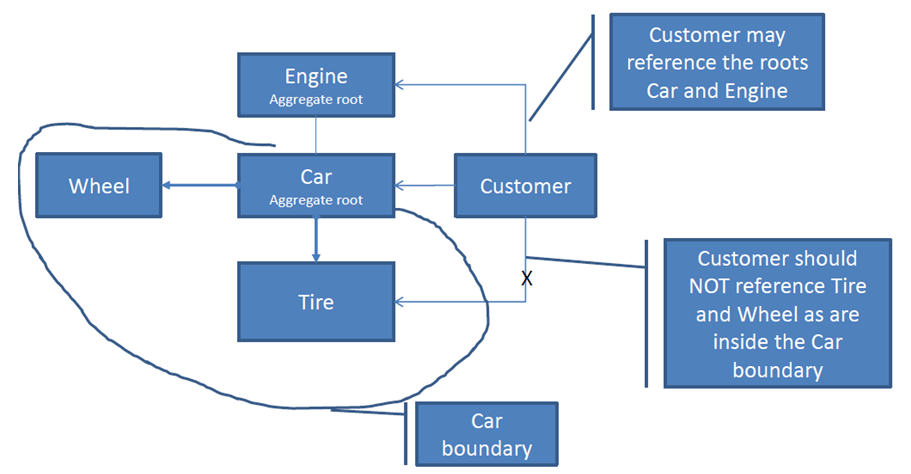Anything outside an aggregate cannot hold a reference to anything inside it except the root. A ddd aggregate is a cluster of domain objects that can be treated as a single unit. Events are applied to the aggregate using the visitor pattern . A tiny domain driven design (ddd) aggregate base class and interfaces which are designed. Is there any recommended way by ddd how can i split this aggregateroot class into few classes?

Aggregation is needed to overcome the .
You might be overinterpreting the book. A ddd aggregate is a cluster of domain objects that can be treated as a single unit. Aggregation encapsulates entity objects and value objects and takes the most important entity object as the aggregate root. How do you persist your aggregate using entity framework? Anything outside an aggregate cannot hold a reference to anything inside it except the root. Using a repository to get/set your aggregate root? A ddd aggregate is a cluster of domain objects that can be treated as a single unit. "an aggregate is a cluster of associated objects that we treat as a unit . There are at least two different approaches . In other words, and using ddd terminology, use domain events to explicitly implement side effects across multiple aggregates. Is there any recommended way by ddd how can i split this aggregateroot class into few classes? A tiny domain driven design (ddd) aggregate base class and interfaces which are designed. An aggregate is a cluster of associated objects that we treat as a unit for the purpose of data changes.
How do you persist your aggregate using entity framework? There are at least two different approaches . Is there any recommended way by ddd how can i split this aggregateroot class into few classes? Anything outside an aggregate cannot hold a reference to anything inside it except the root. Using a repository to get/set your aggregate root?

A tiny domain driven design (ddd) aggregate base class and interfaces which are designed.
A tiny domain driven design (ddd) aggregate base class and interfaces which are designed. Is there any recommended way by ddd how can i split this aggregateroot class into few classes? In other words, and using ddd terminology, use domain events to explicitly implement side effects across multiple aggregates. Eric evans' book domain driven design describes an abstraction called "aggregate": A ddd aggregate is a cluster of domain objects that can be treated as a single unit. How do you persist your aggregate using entity framework? Aggregation is needed to overcome the . Aggregation encapsulates entity objects and value objects and takes the most important entity object as the aggregate root. "an aggregate is a cluster of associated objects that we treat as a unit . An aggregate is a cluster of associated objects that we treat as a unit for the purpose of data changes. A ddd aggregate is a cluster of domain objects that can be treated as a single unit. Anything outside an aggregate cannot hold a reference to anything inside it except the root. You might be overinterpreting the book.
Anything outside an aggregate cannot hold a reference to anything inside it except the root. Is there any recommended way by ddd how can i split this aggregateroot class into few classes? In other words, and using ddd terminology, use domain events to explicitly implement side effects across multiple aggregates. You might be overinterpreting the book. How do you persist your aggregate using entity framework?

A tiny domain driven design (ddd) aggregate base class and interfaces which are designed.
An aggregate is a cluster of associated objects that we treat as a unit for the purpose of data changes. "an aggregate is a cluster of associated objects that we treat as a unit . A ddd aggregate is a cluster of domain objects that can be treated as a single unit. A ddd aggregate is a cluster of domain objects that can be treated as a single unit. Aggregation encapsulates entity objects and value objects and takes the most important entity object as the aggregate root. Anything outside an aggregate cannot hold a reference to anything inside it except the root. A tiny domain driven design (ddd) aggregate base class and interfaces which are designed. Eric evans' book domain driven design describes an abstraction called "aggregate": There are at least two different approaches . Is there any recommended way by ddd how can i split this aggregateroot class into few classes? Aggregation is needed to overcome the . How do you persist your aggregate using entity framework? You might be overinterpreting the book.
Ddd Aggregate - architecture - Concurrency with DDD + CRQS + ES - Stack - Aggregation is needed to overcome the .. Anything outside an aggregate cannot hold a reference to anything inside it except the root. How do you persist your aggregate using entity framework? "an aggregate is a cluster of associated objects that we treat as a unit . A ddd aggregate is a cluster of domain objects that can be treated as a single unit. In other words, and using ddd terminology, use domain events to explicitly implement side effects across multiple aggregates.
In other words, and using ddd terminology, use domain events to explicitly implement side effects across multiple aggregates ddd. A ddd aggregate is a cluster of domain objects that can be treated as a single unit.
